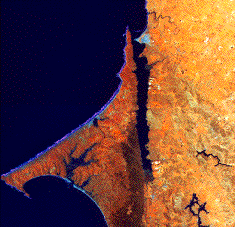
NASA ER-2 false color infrared photograph of Tomales Bay, California, and surrounding watershed. For scale, the bay is approximately 20 km in length and is oriented NW-SE. (NASA photo).
Click on the small pictures to see them at a larger size.
NASA ER-2 false color infrared photograph of Tomales Bay, California, and surrounding watershed.
For scale, the bay is approximately 20 km in length and is oriented NW-SE. (NASA photo).
Click on the small pictures to see them at a larger size.
Between 1985 and 1996, investigators from the University of Hawaii's School of Ocean and Earth Science and Technology (SOEST), San Francisco State University's Tiburon Center, and other institutions studied characteristics of material transport from the land to the bay, internal cycling within the bay, and burial and transport from the bay.
The list of participants on the program can be viewed by pressing here.
The group began a time series analysis of seasonal and interannual variations in this system in 1987. In order to define these variations, field trips occurred at two-month intervals, with some intermediate sampling and automated continuous recording of environmental variables in this system.
The program was divided into six component projects:
1. Analysis of non-conservative nutrient fluxes. This component focused on
sources and sinks of major forms of C, N and P in the bay.
2. Sedimentation analysis. We measured sediment input and accumulation,
in order to quantify loading of land-derived organic matter.
3. Circulation analysis. These studies focused on water circulation, currents,
and exchange of materials between the bay and ocean.
4. Nutrient cycling through major biotic components. We compared
component nutrient fluxes with baywide calculations based on stoichiometric
considerations. The studies considered major plants (phytoplankton, eelgrass, benthic microalgae); and both planktonic and benthic microbial processes.
5. Sites and controls of the processes of denitrification and nitrogen fixation.
6. Modeling land and marine contributions to nutrient fluxes.
All of the field trips included both routine monitoring and related experimental/observational research. Several trips had specific research themes on top of the regular monitoring. Even participants who were not specifically involved with the monitoring studies were encouraged to carry on their research in concert with the monitoring in order to foster active discussion among all research participants. It was considered important that all participants have some general understanding of what was going on in all parts of the research.
Besides the research and training which should be major aspects of any academic research program, this effort had two additional components which proved to be highly successful. During each field trip one or more informal seminars on a topic at least loosely relevant to the Tomales program were held. These seminars proved to be excellent both for sharing ideas within the group and with interested scientists from around the San Francisco Bay area. Secondly, this program actively encouraged the participation of visiting scientists. During most field trips one or more scientists who were not part of the core research program were encouraged (often with travel funding) to come and participate in that trip's research efforts.
In general, these efforts at communication were successful.
The information described in this section represents a combination of accumulated historical knowledge about Tomales Bay and research undertaken during this program.

This page was last updated by SVS April 13, 1998.
Maintained by Stephen V. Smith at svsmith@soest.hawaii.edu